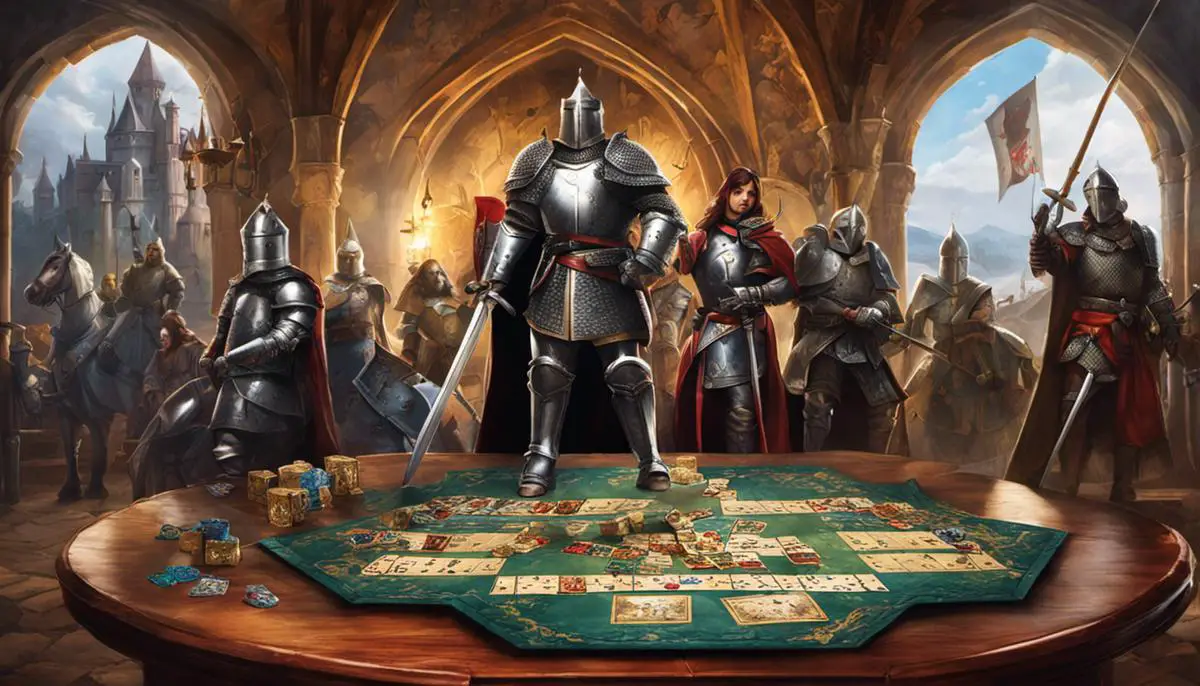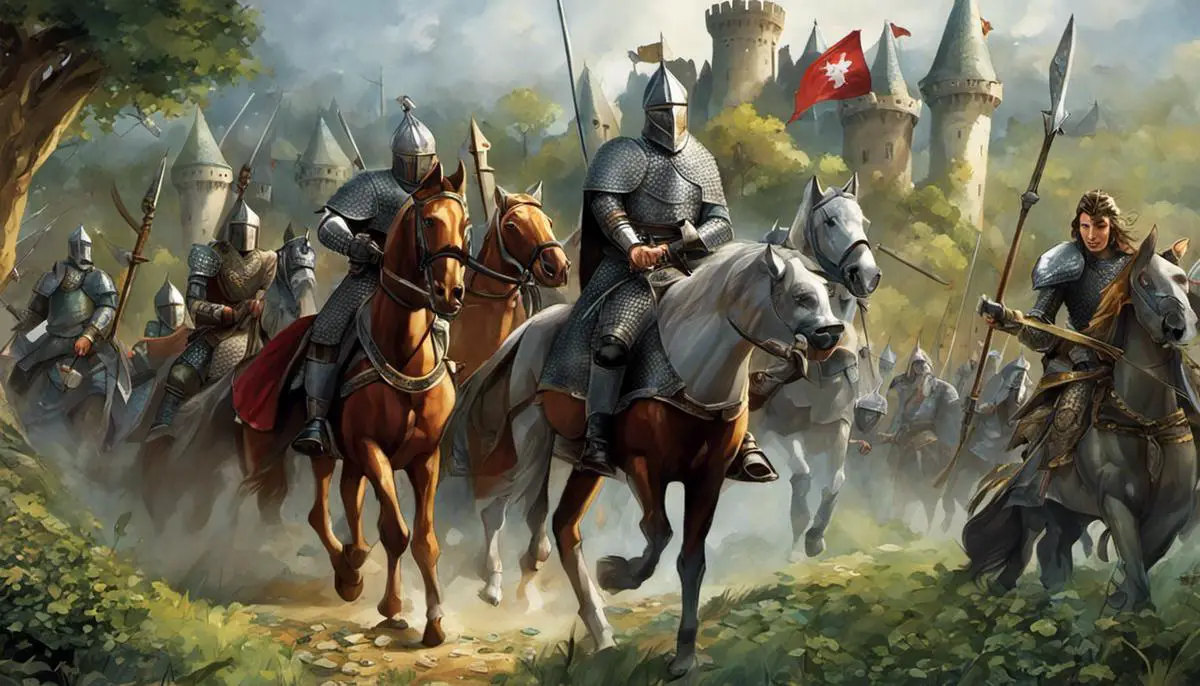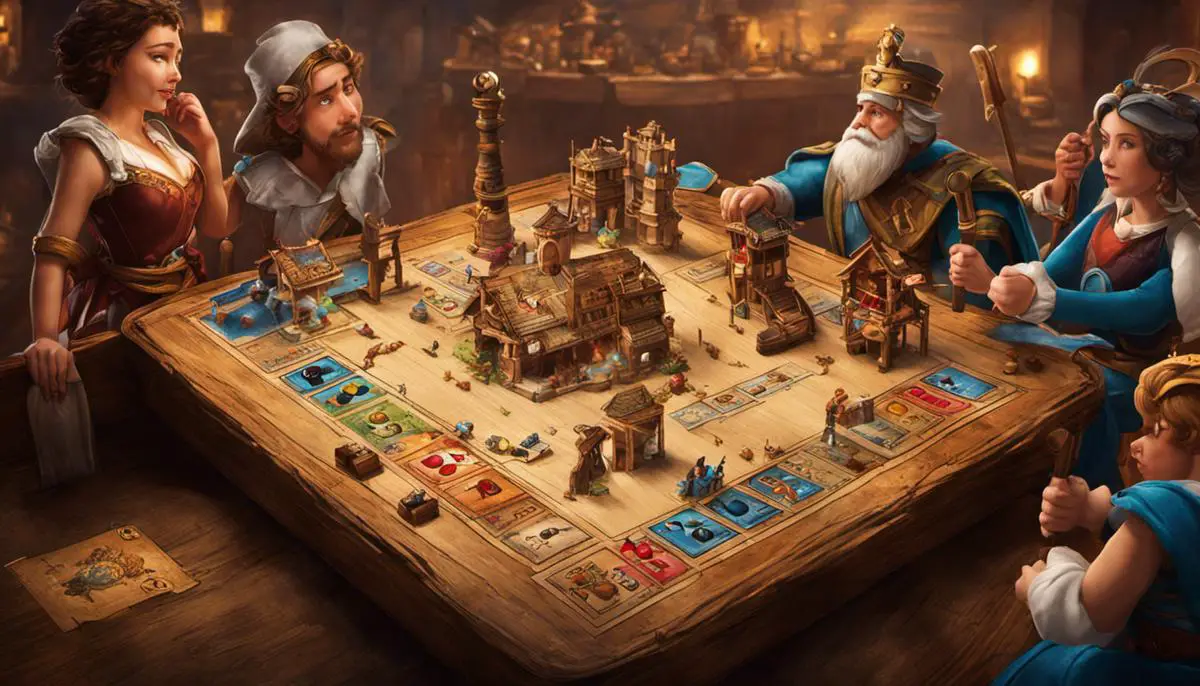Dive right into the world of epic battles and honor with the Shadows Over Camelot board game. Rooted in Arthurian lore, this complex game of loyalty, betrayal, and fearless knights evokes player camaraderie and treachery to create a uniquely thrilling gaming experience. This guide renders profound insight into the game’s principles while imparting effective strategies to master it. With an emphasis on understanding the game’s underlying mechanics—board setup, character utilization, the roles of white and black cards, and catapult handling—it also delves into deciphering the game board and acclimating to the dynamics of various turns. Moving beyond the rudiments, the guide explores strategic plays designed to overcome challenges and navigate tricky sections like the ‘Traitor’ and ‘Accusations’ rounds.
Understanding the Basics
Setting Up the Round Table and Game Board
To set up Shadows Over Camelot, place the round table in the center of the playing area. Start by placing the seven white swords on the table (in seven out of the twelve sword spaces) and draw three black swords to place on the table as well. The final two spaces remain empty. The other pieces, including Siege Engines, swords, and Grail, Picts, and Saxons cards, should be placed on the game board in the marked spaces.
Understanding the Characters
Each player must choose a knight from the available characters – each with their unique abilities that can be leveraged throughout the game. For example, King Arthur can trade cards with other knights, Sir Gawain gains extra actions for fights, and Sir Percival is adept at locating and revealing the hidden loyalty cards. Familiarize yourself with the abilities of each knight to optimize gameplay.
Understanding the Role of White and Black Cards
White and black cards are drawn during the game and can help or hinder the players based on their types. White cards contain helpful tools, such as the Grail and Excalibur, and actions, like healing and drawing additional cards. Black cards, on the other hand, represent Evil’s actions like deploying Siege Engines, drawing black swords, or spawning Picts or Saxons invasions. Recognize the powers of these cards to strategize your moves.
Knowing the Role of the Catapults
Catapults in Shadows Over Camelot symbolize the encroaching forces of evil. They’re placed on the field outside of Camelot, and if there are ever 12 Siege Engines out at once, the players immediately lose the game. Therefore, managing the number of catapults on the board is crucial to survival.
Reading the Game Board
The game board is divided into separate quest areas, each with different requirements to win or lose. Knights, Picts, and Saxons cards are placed on their corresponding areas. Some areas have slots for fight cards that represent the current state of the battle against the enemies. The progression of evil, health of knights, and number of white swords are also displayed on the board. Understanding how to read the game board allows for strategic gameplay and success in the game.
Understanding How Turns Work
Each player’s turn in Shadows Over Camelot consists of two phases: Progression of Evil and Heroic Actions. In the first phase, players can draw a black card, place a catapult, or lose a life point. The second phase allows players to draw or play white cards, fight, heal or accuse (once there are 6 or more Siege Engines or white swords), or move to a new quest. Each turn gives an opportunity to either combat the forces of evil or progress the quests of the knights.

Developing strategies
Forming a Strategy in “Shadows over Camelot”
In Shadows over Camelot, cooperation with other knights forms the foundation of your strategy. A solid team effort can forge the path to victory, so it’s crucial that all players communicate openly and discuss their respective goals and strategies often. Since there is a limit on information sharing during a player’s turn, optimal use of clues becomes a crucial aspect of planning.
Managing Swords in the Round Table
The round table needs a majority of white swords for the knights to triumph over evil. When drawing swords, it’s better to aim for white, but black ones will inevitably come into play. It’s important to strategize ways to convert these. One such strategy could be not completing a quest until a black sword is placed on the table, as completing quests often allows you to switch the sword colors.
Handling ‘Traitor’ and ‘Accusations’
Throughout the game, one player may be a traitor working in secret against the Knights of the Round Table. Players have the opportunity to accuse other players if they believe they are the traitor. It’s important to use this action wisely, as false accusations can lead to more black swords on the table. Observing player activity and testing loyalty through joint quests can be a good way to sniff out possible traitors.
Winning Conditions
The game ends in victory for the loyal knights when there are twelve swords on the Round Table, with majority being white. Alternatively, if a traitor is discovered, their defeat adds an extra sword to the round table. For the traitor, victory comes if there are more black swords on the table at game’s end, or if enough siege engines are placed around Camelot.
Utilizing ‘Heroic Actions’
Heroic Actions are unique moves that can greatly aid the knights in their quest, such as moving to a new quest, playing special white cards, or healing damage. It’s crucial to assess when the best time to use these actions are. For example, it might be best to save healing actions until a player is significantly hurt, or to use special abilities when crucial to the success of a quest.
Using ‘Merlin’ Cards and Special Abilities
Merlin cards can turn the tide when times seem bleak. They can remove siege engines or black swords, but should be saved for critical moments as their number is limited. Similarly, each Knight has a special ability that can be strategically used. For instance, King Arthur’s ability to exchange cards can be used to redistribute cards for optimal quest completion. Understanding how to best leverage these abilities in the right situations can be key to the team’s success.

Playing and Practicing
Understanding the Basics of Shadows Over Camelot
Shadows Over Camelot is a unique board game due to its cooperative mechanics, where players work together as Knights of the Round Table to defend Camelot against various threats. However, one knight might be a traitor trying to sabotage the others. To set up the game, each player picks a knight character with a unique power. Then, shuffle the deck of white cards. Each player draws five of these cards to form their starting hand. Lastly, set up the round table with 12 Siege Engines, 7 white swords, and 7 black swords.
Taking Turns and Progression of the Game
On their turn, a player must first choose a ‘Progression of Evil’ action, which progresses the threats against Camelot. They could either draw a black card, which has negative effects, place a siege engine around Camelot, or lose a life point. After the ‘Progression of Evil’, the active player then takes a heroic action such as moving to a new quest, playing a special white card, healing by discarding three identical cards, or accusing another player of being the traitor. Knights can also fight threats or complete quests by playing fight cards from their hand.
Completing Quests in the Game
In Shadows Over Camelot, completing a quest requires specific sets of white cards. The quest for the Holy Grail, for instance, requires a series of consecutive white cards with a total value of 15 or more. The quest for Excalibur, however, requires a tug-of-war style gameplay where knights use Fighting cards to move the sword closer to their side of the board. Successful completion of a quest earns the knights white swords and additional benefits such as life points or white cards. However, failed quests result in black swords and possibly more siege engines or damage to Camelot.
Identifying The Traitor
An important aspect of Shadows Over Camelot is the possibility of a traitor in the ranks of the knights. If a knight accuses another knight of being a traitor and is correct, the alleged traitor reveals their loyalty card and a white sword is placed on the round table. Incorrect accusations, however, turn white swords into black ones. The traitor wins if there are more black swords than white upon the game’s end or if Camelot falls due to an abundance of siege engines or lack of knights.
Win or Lose as a Team
The game ends when there are twelve swords on the round table, either black or white pending the completion of quests or accusations. If there are more white than black swords, the loyal knights win. But if the traitor’s sabotage is successful and results in more black swords, the knights lose. The game can also abruptly end in defeat if either twelve siege engines surround Camelot or all loyal knights die.
To become efficient in playing Shadows Over Camelot and winning as a knight, practice different strategies to successfully complete quests, responsibly accuse probable traitors, and lastly, keen observation skills to detect the traitor amongst the knights. Regularly playing the game will enable you to understand the game’s mechanics, view patterns, and calculate critical risks aligned with each heroic action.

Strategic mastery in Shadows Over Camelot does not merely result from reading about it but demands robust practice and actual gameplay. Experiencing a variety of scenarios and incorporating different strategies fortify learning and enhances adaptation skills in evolving game situations. Hence, regular play is integral to internalizing rules, sharpening strategic abilities, and navigating the game’s challenges adeptly. As players engage more with the game, they begin to apprehend the subtle nuances and tactical profundity of Shadows Over Camelot; and through this journey of demystifying and conquering the game, they will find that the true thrill lies not just in winning, but in the strategizing, cooperating, accusing and defending that conspire to create each game’s unique narrative.
